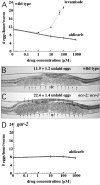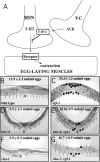Genetic and cellular basis for acetylcholine inhibition of Caenorhabditis elegans egg-laying behavior
- PMID: 12954868
- PMCID: PMC6740490
- DOI: 10.1523/JNEUROSCI.23-22-08060.2003
Genetic and cellular basis for acetylcholine inhibition of Caenorhabditis elegans egg-laying behavior
Abstract
Egg-laying behavior in Caenorhabditis elegans is activated by signaling through the G-protein G(rho)q and inhibited by signaling through a second G-protein, G(rho)o. Activation of egg laying depends on the serotonergic hermaphrodite-specific neurons (HSNs), but the neurotransmitter(s) and cell(s) that signal to inhibit egg laying are not known. Mutants for G-protein signaling genes have well characterized defects in egg laying. Here we present an analysis of mutants for other genes reported to lack inhibition of egg laying. Of the nine strongest, six have morphological defects in the ventral-type C (VC) neurons, which synapse onto both the HSNs and the egg-laying muscles and are thus the third cell type comprising the egg-laying system. Laser-ablating VC neurons could also disrupt the inhibition of egg laying. The remaining three mutants (unc-4, cha-1, and unc-17) are defective for synthesis or packaging of acetylcholine in the VCs. The egg-laying defects of unc-4, cha-1, and unc-17 were rescued by VC-specific expression of the corresponding cDNAs. In addition, increasing synaptic acetylcholine by reducing acetylcholinesterase activity, with either mutations or the inhibitor aldicarb, decreased egg laying. Finally, we found that a knock-out for the HSN-expressed receptor G-protein-coupled acetylcholine receptor 2 (GAR-2) shows a partial defect in the inhibition of egg laying and fails to respond to aldicarb. Our results show that acetylcholine released from the VC neurons inhibits egg-laying behavior. This inhibition may be caused, in part, by acetylcholine signaling onto the HSN presynaptic terminals, via GAR-2, to inhibit neurotransmitter release.
Figures






References
-
- Alfonso A, Grundahl K, Duerr JS, Han HP, Rand JB ( 1993) The Caenorhabditis elegans unc-17 gene: a putative vesicular acetylcholine transporter. Science 261: 617-619. - PubMed
-
- Baran R, Aronoff R, Garriga G ( 1999) The C. elegans homeodomain gene unc-42 regulates chemosensory and glutamate receptor expression. Development 126: 2241-2251. - PubMed
Publication types
MeSH terms
Substances
Grants and funding
LinkOut - more resources
Full Text Sources
Miscellaneous
